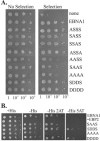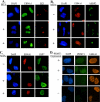Regulation of the EBNA1 Epstein-Barr virus protein by serine phosphorylation and arginine methylation
- PMID: 16699006
- PMCID: PMC1472174
- DOI: 10.1128/JVI.02682-05
Regulation of the EBNA1 Epstein-Barr virus protein by serine phosphorylation and arginine methylation
Abstract
The Epstein-Barr virus (EBV) EBNA1 protein is important for the replication and mitotic segregation of EBV genomes in latently infected cells and also activates the transcription of some of the viral latency genes. A Gly-Arg-rich region between amino acids 325 and 376 is required for both the segregation and transcriptional activation functions of EBNA1. Here we show that this region is modified by both arginine methylation and serine phosphorylation. Mutagenesis of the four potentially phosphorylated serines in this region indicated that phosphorylation of multiple serines contributes to the efficient segregation of EBV-based plasmids by EBNA1, at least in part by increasing EBNA1 binding to hEBP2. EBNA1 was also found to bind the arginine methyltransferases PRMT1 and PRMT5. Multiple arginines in the 325-376 region were methylated in vitro by PRMT1 and PRMT5, as was an N-terminal Gly-Arg-rich region between amino acids 41 and 50. EBNA1 was also shown to be methylated in vivo, predominantly in the 325-376 region. Treatment of cells with a methylation inhibitor or down-regulation of PRMT1 altered EBNA1 localization, resulting in the formation of EBNA1 rings around the nucleoli. The results indicate that EBNA1 function is influenced by both serine phosphorylation and arginine methylation.
Figures








Similar articles
-
Interaction between basic residues of Epstein-Barr virus EBNA1 protein and cellular chromatin mediates viral plasmid maintenance.J Biol Chem. 2013 Aug 16;288(33):24189-99. doi: 10.1074/jbc.M113.491167. Epub 2013 Jul 8. J Biol Chem. 2013. PMID: 23836915 Free PMC article.
-
Optimal transactivation by Epstein-Barr nuclear antigen 1 requires the UR1 and ATH1 domains.J Virol. 2009 May;83(9):4227-35. doi: 10.1128/JVI.02578-08. Epub 2009 Feb 25. J Virol. 2009. PMID: 19244333 Free PMC article.
-
Nucleophosmin contributes to the transcriptional activation function of the Epstein-Barr virus EBNA1 protein.J Virol. 2014 Feb;88(4):2323-6. doi: 10.1128/JVI.02521-13. Epub 2013 Nov 27. J Virol. 2014. PMID: 24284322 Free PMC article.
-
EBNA1.Curr Top Microbiol Immunol. 2015;391:3-34. doi: 10.1007/978-3-319-22834-1_1. Curr Top Microbiol Immunol. 2015. PMID: 26428370 Review.
-
Potential cellular functions of Epstein-Barr Nuclear Antigen 1 (EBNA1) of Epstein-Barr Virus.Viruses. 2013 Jan 16;5(1):226-40. doi: 10.3390/v5010226. Viruses. 2013. PMID: 23325328 Free PMC article. Review.
Cited by
-
Small Molecule Inhibitors of Protein Arginine Methyltransferases.Expert Opin Investig Drugs. 2016;25(3):335-58. doi: 10.1517/13543784.2016.1144747. Epub 2016 Feb 16. Expert Opin Investig Drugs. 2016. PMID: 26789238 Free PMC article. Review.
-
Functional diversity: update of the posttranslational modification of Epstein-Barr virus coding proteins.Cell Mol Life Sci. 2022 Nov 14;79(12):590. doi: 10.1007/s00018-022-04561-2. Cell Mol Life Sci. 2022. PMID: 36376593 Free PMC article. Review.
-
Cryo-EM Structure and Functional Studies of EBNA1 Binding to the Family of Repeats and Dyad Symmetry Elements of Epstein-Barr Virus oriP.J Virol. 2022 Sep 14;96(17):e0094922. doi: 10.1128/jvi.00949-22. Epub 2022 Aug 29. J Virol. 2022. PMID: 36037477 Free PMC article.
-
Protein arginine methyltransferase 1-directed methylation of Kaposi sarcoma-associated herpesvirus latency-associated nuclear antigen.J Biol Chem. 2012 Feb 17;287(8):5806-18. doi: 10.1074/jbc.M111.289496. Epub 2011 Dec 16. J Biol Chem. 2012. PMID: 22179613 Free PMC article.
-
Modulation of Epstein-Barr virus nuclear antigen 2-dependent transcription by protein arginine methyltransferase 5.Biochem Biophys Res Commun. 2013 Jan 18;430(3):1097-102. doi: 10.1016/j.bbrc.2012.12.032. Epub 2012 Dec 19. Biochem Biophys Res Commun. 2013. PMID: 23261437 Free PMC article.
References
-
- Barwell, J., A. Bochkarev, R. Pfuetzner, H. Tong, D. Yang, L. Frappier, and A. Edwards. 1995. Purification and crystallization of the DNA-binding and dimerization domain of the Epstein-Barr virus nuclear antigen 1. J. Biol. Chem. 270:20556-20559. - PubMed
-
- Bedford, M. T., and S. Richard. 2005. Arginine methylation an emerging regulator of protein function. Mol. Cell 18:263-272. - PubMed
-
- Blake, N., S. Lee, I. Redchenko, W. Thomas, N. Steven, A. Leese, P. Steigerwald-Mullen, M. G. Kurilla, L. Frappier, and A. Rickinson. 1997. Human CD8+ T cell responses to EBV EBNA1: HLA class I presentation of the (GLY-ALA) containing protein requires exogenous processing. Immunity 7:791-802. - PubMed
Publication types
MeSH terms
Substances
LinkOut - more resources
Full Text Sources
Other Literature Sources

